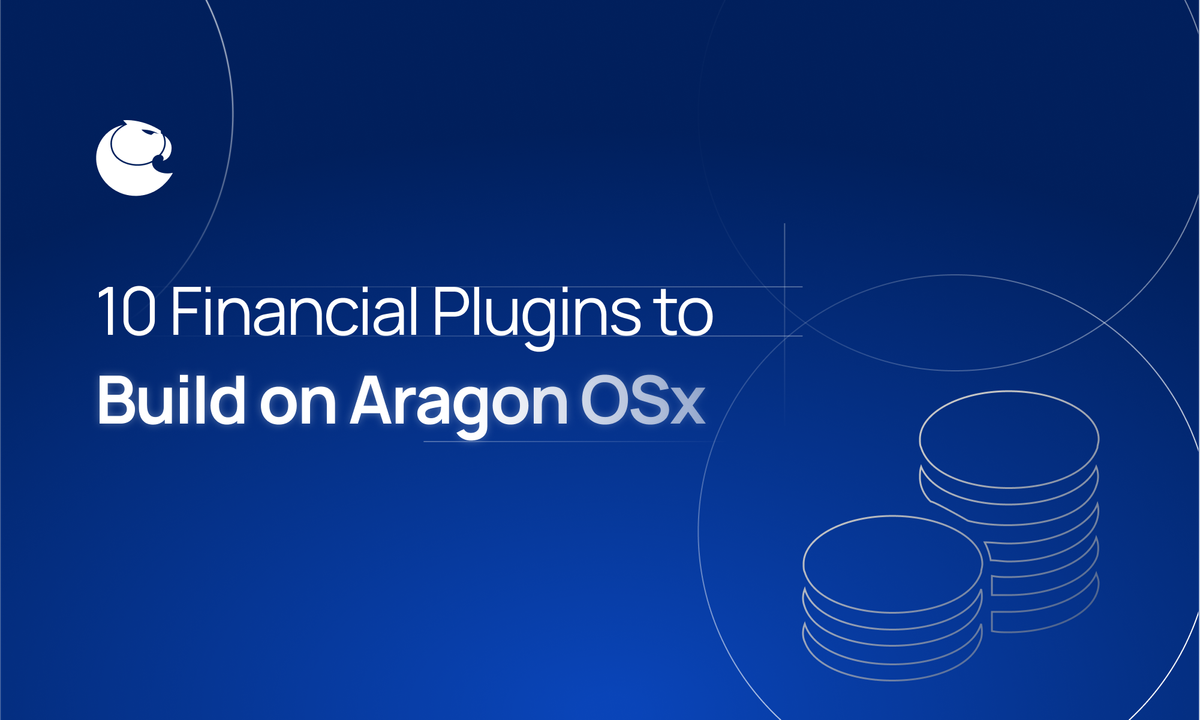10 financial plugins you can build on Aragon OSx

Plugins extend what DAO can do. Think of it as an app that you install and uninstall on your phone or computer. It adds more things a DAO can do, such as exchanging tokens or adding new decision-making methods.
Plugins are how Aragon OSx DAO adapts and evolves. Installing and uninstalling a DAO can change the governance, finances, and membership aspects of the DAO.
Here are 10 ideas to help you get started building your finance plugin today!
“By leveraging Aragon’s flexibility, composability, and compatibility, DAO builders can experiment and refine their ideas in a step-by-step development process. This approach not only reduces the risk and cost of failure, but also fosters innovation and creativity within the Web3 ecosystem.”
—JusticeDAO expert specializing in custom DAO and Aragon plugins

1. Exchange your tokens at the best price
yes: Matcha
It can be difficult to know if you are getting the best price for a token swap. You can build a plugin that integrates with a DEX aggregator like Matcha to show you the best swap prices. Or choose your favorite DEX, check the swap price of each DEX in advance and choose the DEX that suits you best.
This plugin allows DAOs to easily exchange tokens at the best price and easily manage their finances.
For inspiration, check out Libree (formerly Sassy Finance), which recently built a Uniswap plugin to enable swaps directly on DAOs!

2. Voting rights proportional to investment size
Investment DAOs are on-chain organizations made up of people pooling assets to jointly generate investment returns. One way to run an investment DAO is to distribute voting rights to members in proportion to the funds they have invested in the DAO. Depending on the size of your investment, you will receive the same voting rights back as governance tokens.
You can build a plugin to automate this process and return the same voting power to the depositor in voting tokens, and require them to burn those tokens before withdrawing their assets. This means that members do not need trust to exit the system. They can simply burn governance tokens and take a proportional portion of the treasury.

3. Vesting period of DAO governance tokens
Rewarding DAO contributors with governance tokens can help create value alignment among contributors, as everyone wants their tokens to increase in value.
You can create a plugin that grants DAO governance tokens to contributors for a set period of time, ensuring that only longer-staying contributors have access to the full token vesting package. This can encourage members to act in ways that are beneficial to the DAO as a whole.

4. Staking directly on DAO
Staking is a common way to earn returns on your assets. DAOs holding ETH may want to stake it on a staking service such as Lido. You can build a plugin that allows you to easily stake ETH directly in the DAO. The DAO can then earn profits and increase its treasury.
If the DAO wants to unstake an asset, the plugin can be used again to return the original asset to the vault.

5. Token streaming
yes: superfluid
Guilds and individuals requesting funds from the DAO will need a way to receive those funds, and paying everything upfront can be risky because the project could disappear without being completed. There is no way to be held accountable, especially if it is anonymous.
Token streaming plugins like Superfluid mean that DAOs can stream tokens directly to contributors without having to create new offerings to send funds every few weeks. You can build a plugin that allows Aragon OSx DAO to easily stream tokens without having to use another application.

6. End Anger
yes: Dao House / Moloch Dao skeleton
Exit Rage involves burning governance tokens and taking an equal portion of the treasury. This is a way to “exit” the DAO and recoup your initial investment without having to trust the DAO members.
You can build a plugin to enable rage shutdown for DAOs built on Aragon OSx. DAOs that raise capital from members can maintain opt-out rights by installing this plugin.

7. Airdrop/automatic distribution according to parameters
yes: Coinvice
Some DAOs start their communities by airdropping tokens to wallets that perform actions they want to incentivize, such as interacting with the protocol. This can create an almost instant community because you are united by a common interest.
You can easily create a plugin that can automatically and easily deploy governance tokens to wallets that perform the desired actions. This plugin can be used not just initially, but later throughout the DAO’s life to continue to encourage this behavior. Alternatively, the airdrop plugin works by taking a CSV file of addresses and issuing tokens to those addresses once the vote passes.

8. Off-chain and cross-chain asset tracking
Some organizations have a DAO and a traditional bank account. Others have multiple DAOs on different chains, each holding different assets. To gain visibility into the organization’s overall financial health, members should check the status of their assets outside the DAO.
The plugin can share real-time asset prices of DAO off-chain assets with the UI. On-chain smart contracts allow the use of oracles to share information off-chain, such as the price of gold.
The cross-chain asset tracking plugin works similarly, using oracles to pull data from other organizations to give you a full picture of your DAO’s finances. These plugins could even be the start of a dApp to run an investment DAO built on Aragon OSx, like Libree!

9. Automated DeFi Strategy
yes: Wizzy
Many DAOs want to be able to execute their DeFi strategies without having to constantly pass votes and take action as a community. Cryptocurrency financial management is a specific skill that generally does not require the input of the entire community to perform.
You can build plugins to implement complex strategies like swapping and staking, without community voting and with only the approval of verified financial managers. We then program an automatic DeFi strategy that runs as long as you vote “yes”.

10. Asset management authority for SubDAO
Inspiration: free
Another way to approach asset management in a DAO is to use a subDAO. You can build a plugin that authorizes a subDAO to manage the assets in the main DAO’s treasury. A subDAO may consist solely of the DAO’s treasury managers and may be managed by approved wallet voting (e.g. multi-sig).
The main DAO can revoke permissions to the subDAO at any time through a vote, increasing security.

Start building your own plugin today
Select one of the following links to start building your own plugin today! We look forward to seeing what you create.
📝 How to build a DAO plugin guide
🎥 Video on how to build a DAO plugin
👩🏻💻 Developer Documentation
🌎 Project built on Aragon OSx
👾 Join our Discord



